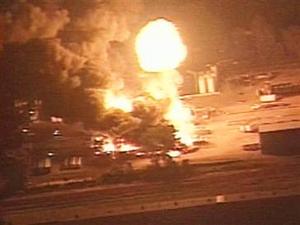Chemical facilities securityChemical industry spends millions shaping chemical facilities security legislation
Fourteen parent companies own chemical plants which endanger a large number of people in the United States in the event of an accident or attack on one of their chemical facilities; these 14 parent companies own 163 facilities in 37 different states and Puerto Rico; the facilities owned by The Clorox Company, Kuehne Chemical, and JCI Jones Chemical each put more than 12 million people at risk; these fourteen companies and their affiliated trade associations spent $69,286,198 lobbying the committees with jurisdiction over chemical security legislation in 2008 and 2009; the political action committees (PACs) of these fourteen companies and the PACs of their affiliated trade associations gave $2,187,868 in the 2008 election cycle and the 2010 cycle to date directly to the campaigns of members of the committees of jurisdiction over chemical security legislation

Legislation seeks to minimize the public impact of chemical plant disasters // Source: dipity.com
Across the United States, thousands of industrial facilities use and store hazardous chemicals in large quantities that pose major risks to their neighbors. More than 100 of these facilities would each put at least one million people at risk of injury or death in the event of a chemical release.
In a new study of the issue, U.S. PIRG reports that addressing this should be a top priority, because accidents at chemical and industrial facilities are common. From 2000 to 2009, companies, employees, and concerned citizens reported more than 338,000 accidents involving oil or chemicals to the National Response Center (NRC), or more than 33,000 incidents every year. These accidents range from an oil sheen to a major disaster that resulted in casualties.
PIRG notes that after the 9/11 attacks, it became increasingly apparent that these facilities pose a security threat, as they could become the target of a terrorist attack. A report by the Army Surgeon General ranked an attack on a chemical plant second only to a widespread biological attack in magnitude of the hazard to the public. “These are often unnecessary dangers because safer alternatives are available.” PIRG asserts.
Some facilities have made major progress by switching to the use of safer chemicals and processes that pose less of a threat to surrounding communities in the event of an accident (“New survey shows many water, wastewater plants improve chemical security,” 9 March 2010 HSNW). Soon after 9/11, for example, the Blue Plains Sewage Treatment Plant in Washington, D.C. switched from using and storing chlorine gas and sulfur dioxide on-site to using sodium hypochlorite bleach in its processes.
On 2 November 2009, Clorox announced that it will, over the next several years, convert its seven U.S. plants to use high-strength bleach rather than chlorine in the manufacturing of household bleach. The company began with its Fairfield, California, plant and will switch its six other U.S. plants over the coming years (“Clorox announces plans to transition U.S. operations to high-strength bleach,” 5 November 2009 HSNW).
PIRG says that, unfortunately, most industry organizations have placed emphasis on increasing physical site security measures. “Hiring more guards, building higher fences, and placing more lights may all be part of a good security plan, but this does not actually reduce the threat to the community,” the nonprofit public policy organization says.
Switching to safer chemicals and processes not only reduces the chemical hazard to the community,
